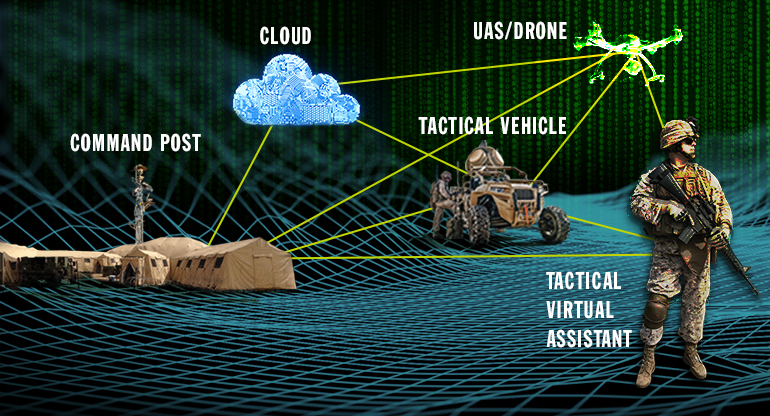Cloud-style services to improve insight no matter the domain
A warfighter on reconnaissance peers across a valley to gather information and sees a vehicle commonly used by friendly local forces. The warfighter runs a machine learning inference process against the local video feed on a wearable “Tactical Virtual Assistant" device and receives a notification on the heads-up display of an augmented-reality (AR) headset that this vehicle belongs to friendly forces.
But the warfighter knows that local forces had been overrun and adversaries are behind the wheel of this vehicle. Through SAIC’s Edge Services hub on the Tactical Virtual Assistant device, the warfighter corrects the artificial intelligence’s (AI’s) inference, which is then transmitted to squad mates and then up to a commander’s command outpost application. By correcting the output, it serves as a more accurate input for the future.
The deluge of data at the tactical edge can be overwhelming for government customers. Warfighters and commanders need AI orchestration at the edge to accurately understand everything in their battlespace and to constantly work to improve one another, especially when lives are on the line.
Enter SAIC Edge Services, which bring virtually any cloud-driven service to any localized environment, even the tactical edge, by utilizing a set of validated hardware platforms paired with data transport options and a modular data architecture. Edge Services enable organizations to gather, receive, and process multi-domain, mission-critical information faster and more holistically.
And the Tactical Virtual Assistant is a low-power, compact, tactical cloudlet the size of a smartphone that brings networking and application hosting capabilities with it. A hands-free or tablet-based interface allows a user to input corrections to the AI, as the device was designed for ease of use and not to interfere with warfighters' tasks at hand.
Through Edge Services, intelligence is distributed across the entire edge, humans and devices alike, using state-of-the-art communications systems like 5G, Internet of Things (IoT) hardware, sensors, and high-performance applications. When the warfighter above corrects the AI output, for example, all warfighters and devices receive that correction and maintain cohesion. Each Edge Sevices hub can also host a variety of services, like blockchain, advanced analytics, or simple data storage.
This allows us to do true AI on the tactical edge. We can provide a wide variety of AI-derived services on a platform as small as a microdrone or a wearable.
Correcting computational error
Misidentifying a vehicle could prove dangerous. Incomplete, inaccurate insights can make or break mission success. This is why user correction is a critical arm of SAIC Edge Services, as it reinforces our country’s commitment to AI ethics by maintaining a human-in-the-loop system without distraction or hesitation. Our brave teams of men, women, and machines work together at the speed of thought.
“It’s more than human-in-the-loop,” added Nathan Verrill, SAIC Edge Services senior engineer. “One observer might have a bigger picture, one a view obscured to others, and yet another years of experience that the algorithms and data scientists do not.”
“Data streams are multi-sensory and not limited to what is seen: the sound underwater, vibrations beneath our feet and the smell in the air,” Verrill continued. “They all factor into the evolution of AI.”
Current AI models are very brittle, meaning they are easy to disrupt, interrupt, or trick. Using humans to correct the machine significantly mitigates this.
Meshing the battlefield together
Rather than importing data into clunky tablets, warfighters can interact directly with the cloud through devices like the Tactical Virtual Assistant. It crunches data, finds what is useful, and transmits the data to other IoT hubs in the battlefield, whether that’s a computer system in the squad’s vehicle or a nearby unmanned aerial system (UAS).
Each hub can run disconnected and treat other hubs as peers in a mesh network. Since each hub can host applications other hubs can access, a group of devices can aggregate storage, compute, and applications as needed. Each hub, whether it is a vehicle-mounted compute node, a Tactical Virtual Assistant device, or a hub running on a UAS, utilizes the best data transport path possible to communicate as needed. Transport protocols include advanced, low-power, difficult to detect waveforms like LoraWAN, LTE, Bluetooth, tactical radio, and even non-RF data transmission using optical processing.
Peer nodes can be unmanned aerial vehicles with onboard GPU processing that allow for autonomous operation and reaction in real time. This can allow local compute resources to process data collected during a mission and immediately broadcast information to an asset that can change its behavior based on new information. This capability is what we call the “Smart Tactical Mesh.”
Strengthening situational awareness
Because of Edge Services, squads can deploy highly portable mission command centers, offering unprecedented situational awareness and tactical advantage on the front lines. Any group of Edge Services-equipped compute devices can be joined to form part of a composable and decomposable command-and-control (C2) capability with shared services. Teammates can gather and share data, gain situational awareness, and then disperse rapidly, taking an operating local compute environment with them.
Maintaining tactical advantage requires unprecedented information logistics, speed, and ease of use. Most important, it requires working as orchestrated teams using novel communications, plus AI algorithms that become smarter and smarter, backed by human judgment.
In a chaotic environment, operators need to be able to make split-second informed decisions. We can put our processor on something and do inference tasks. But tying all this together and being able to do this on that extreme edge compute environment is the key to Edge Services.
To learn more about our Tactical Virtual Assistant and contact our experts about SAIC Edge Services, view our fact sheet.
And, for more exploration, visit SAIC's Internet of Battlefield Things site.


